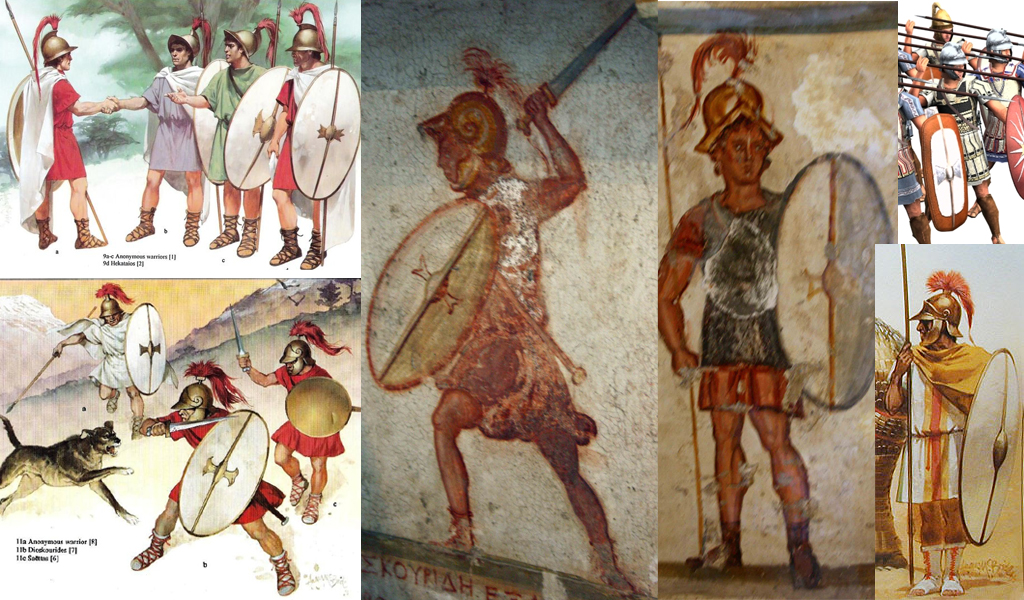
References for late Hellenistic Thureophoroi (left) and Thorakitai (right)
In Greek, Thureo/phoros means "shield"/"bearer". The Thyreos shield however also meant "door" to the thyreophoros, θυρεοφόρος carried a door-shaped shield, inspired the by rolling ovoïd tomb stones. They appeared in the 3rd to 1st centuries BC but could have existed before. Their main true inspiration could have been the Celtic shields, from after the 280 BC Gallic invasions of Greece, Thrace and the Balkans which left a tremendous impression. They were made of wood, approx. one meter to 1,20 m high, 60 cm large, with a central metal strip boss and spine as reinforcement. The Thureos had the advantage contrary to the classic Hoplon, to better protect the body below the groin (for lack of cnemids), and was light, probably made of wooden planks assembled and then doubled by hide, with a possible metal rim all around or on top. The face was probably often painted with recoignition symbols, medusa heads or winged ornaments (as for the seleucid argyrapids).
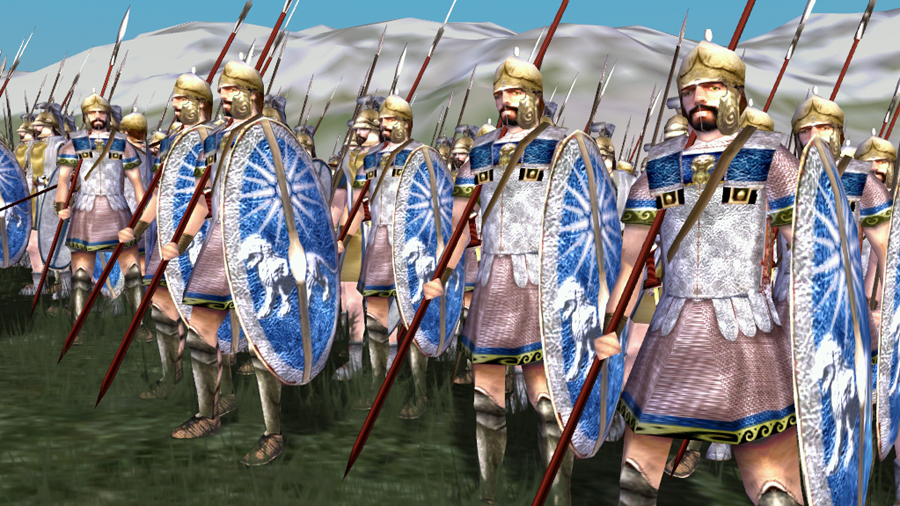
Pontic Thureophoroi
The same shield, or a similar version was also used by peltasts, of the late greek imitation type. These had little to do in fact with the original Thracian round or crescent pelte. So the idea of training and using Thureophoroi could have been as to improvize on the battlefield a kind of peltast armed with a dory (the standard Greek three meters spear) to act as quick plug infantry, or chasing other peltasts, replacing in effect the old Ekdromoi Hoplites (which were in effect a young hoplite devoid of any armour but keeping a hoplon, a shield and possibly a dory). The idea resurfaced under Alexander's rule as the Hypaspistai, carrying an aspis, the other name for the hoplon, as a fast, elite, but still light infantry.
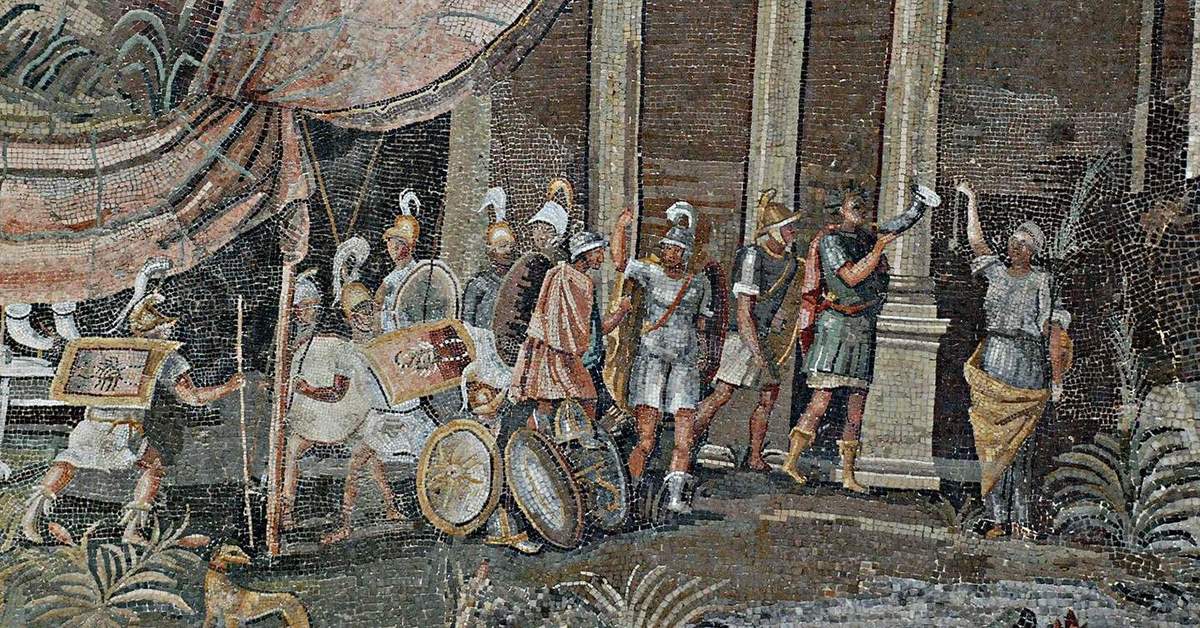
Depiction of a Ptolemaic medium infantry - Mosaic of Palestrina, IIth century BC. This interesting depiction shows an array of soldiers with tunics, possibly light armour and chainmail, wearing boots and thracian plumed helmets, spears, and also displaying a large array of shields. One is round, another ovale and two are indiscutably thureos, but some appeared squared, which is highly unusual.
Another possible inspiration for the type has been the Iphrikrates Hoplites sometimes also called "light hoplites". Invented by Athenian General Iphikrates, this kind of "light hoplite" was influenced by the mercenary peltast gear. They kept the round pelte, abandoned the heavy bronze cuirass for a light linen, paddled, quilted, or leather one, their greaves and sandals replaced by Thracian foxskin boots. Moreover they swapped their javelins for a longer than average dory and better sword. Lately in 280 BC they adopted a two handed spear, which was allowed by the smaller pelte. This infantry is generally believed to have been in turn strongly influenced by the Macedonian phalanx, but it influenced also the concept of thureophoroi. A variant of this kind of reformed infantry of the IVth/early IIIth cent. indeed carried a shorter spear and a thureos, and may have been also the true ancestor of the Thyreophoroi in the late IIIth cent.
The Thureophoroi in litterature
There are several depictions (many more has been probably lost when Alexandria's library burnt) of this infantry type, some of which are unclear and still fuels debate today among specialists in ancient warfare. Most of the time they are described as javelins launchers, but also using a spear. One particular description is due to Polybius when he described his grandfather Philopoemen using a peculiar tactic at Mantinea in 207 BC, confirmed by Plutarch when he described some kind of light infantry acting like peltasts, but then retreating before the advancing phalanx to pick up long spears and hold their ground. It should be noted however that the Achaean League eventually abandoned the thyreos around 208-207 BC in favor of the heavier Macedonian phalanx. The Boeotians adopted this kind of infantry also in the 270s BC (they used early on the Iphikratean hoplite). Thyreophoroi then were frequently described -to add to confusion- as mercenaries using this kind of shield, without precision of their armament or battle tactic but were reputed as "not reliable in hand-to-hand fighting" which can induce these were heavy peltasts and probably not given any armour or greaves. This new infantry became so influencial nevertheless that was developed the thyreomachia, an athletic event in many Greek competitions, matching the old "run with hoplitic gear".
Indeed it's difficult to imagine in reality how this medium infantry should have carried a long spear -rather cumbersome- in addition to javelins and personal sword. There is no description of the sword type either, likely the straight, symmetrical type used by hoplites, slashing kopis and machaira being reserved for cavalry most of the time.
On the tactical plan, they were used for harassing and flanking troops by the successor states. They formed a link between the light infantry and the phalanx, a form of medium infantry to bridge the gaps. They used primarily the thrusting spear, but could have used javelins in some occasion. Early on, Pyrrhus of Epirus learnt quickly from the Romans and introduced lighter troops in between the units of their phalanx. Same happened with Antigonus II Gonatas at Sellasia in 222 BC.
The Achaean league largely used Thureophoroi, to their advantage, using their better mobility against the slow-moving phalanx. So did the Seleucids, which used them proficiently. They still had been used conservatively by Diadochis, at least until 140 BC Ascepiodotos reforms in Egypt, which massively introduced a new kind of medium infantry, largely influenced both by celtic Mercenaries and previous intermediary unit types. These late reformed "light thureophoroi" were described as carrying either a spear, a sword, or both. They are shown unarmoured except for the plumed helmet. They were probably drawn from the same class as the pezhetairoi, and well-trained, moderately well equipped.
Towards the Thorakitai
The richest or most rewarded veterans became likely thorakitai, either armoured with a chainmail (also a western influence) or eastern-type scale armour. In any case these armour was not supposed to make the infantry loose its agility as it is described to have been used to clear the heights from enemy light infantry, and climbing the Elbruz under Antiochos III. Polybius also described 5,000 Seleucid infantrymen in 166 BC armed in the 'Roman' fashion at a parade at Daphne. Antiochus IV's reformed infantry nevertheless was still armed with a spear, not a sword as a main weapon, and they only formed a moderate part of what was still largely a phalanx-based combined army where Roman influence was far more limited that posterior Latin authors argues. This influence was probably greater at the time of the Roman civil wars, shortly before or after when Pontic, seleucid, Armenian, Numidian or Egyptian "imitation legionaries" appears. Even at the time of the 3rd Punic war, Carthage's African veteran infantry is also described using the "Roman shield", and chainmail, alongside a thrusting spear.
Plutarch, Life of Philopoemen, 9
Pausanias, Description of Greece
Liddell, Henry George; Scott, Robert; A Greek–English Lexicon, Perseus Project
others: Head, Duncan (1982). Armies of the Macedonian and Punic Wars
Sabin, Philip & van Wees, Hans & Whitby, Michael (eds.) (2007). "The Cambridge History of Greek and Roman Warfare".
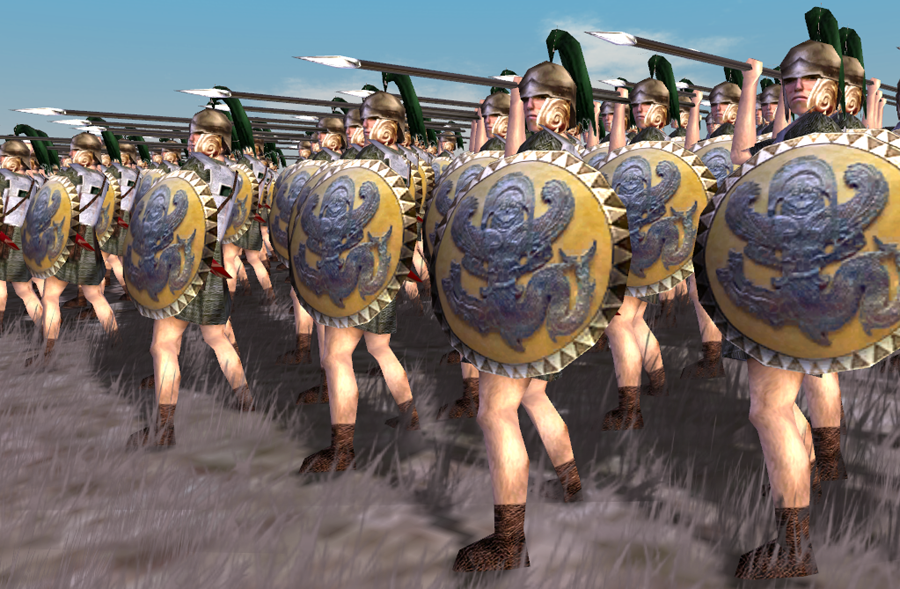
Ekdromoi/Keles Hoplitai or "fast hoplites", a development of the pelopponesian war intended to catch peltasts (including heavy peltasts that were Greek adaptations of the Thracian peltast, with thureos, javelins and a sword; They were a response to Iphikrates reformed infantry, part hoplites/part peltasts used by the Athenians and Thebans.

Alexander's army hypaspistai, light shield bearers. These replaced the Peloponnesian era Ekdromoi hoplitai or "chase, fast" hoplites developed to chase peltasts, and incidentally attack the wings of an hoplitic formation.

Late Romanized infantry (140 BC): Macharaiphoroi and Thorakitai Argyraspidai
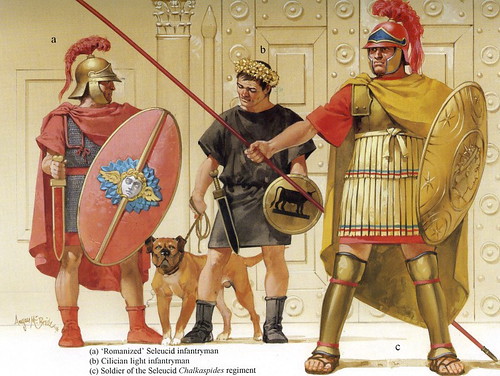
Left: Late seleucid Romanized infantry (140 BC): Thorakitai Argyraspidai

Pontic Kingdom imitation Legionaries - Mithridatic wars 88-63 BC
♕ Aquitani & Vasci ♕ Celts ♕ Indo-greeks ♕ Veneti ♕ Yuezhi ♕ Indians ♕ Etruscans ♕ Numidians ♕ Samnites ♕ Judaean ♕ Ancient Chinese ♕ Corsico-Sardinians
⚔ Cingetos ⚔ Immortals ⚔ Cavaros ⚔ Cataphract ⚔ Romphaiorioi ⚔ Chalkaspidai ⚔ Devotio Warrior ⚔ Scythian Horse archer ⚔ The Ambactos ⚔ Iberian warfare ⚔ Illyrian warriors ⚔ Germanic spearmen ⚔ Carthaginian Hoplite ⚔ Thracian Peltast ⚔ Caetrati ⚔ Ensiferi ⚔ Hippakontistai ⚔ Hastati ⚔ Gaesatae ⚔ Cretan Archer ⚔ Thorakitai ⚔ Soldurii ⚔ Iphikrates ⚔ Kardaka ⚔ The thureophoroi